
Acianthus, commonly known as mosquito orchids, is a genus of about twelve species of plants in the orchid family, Orchidaceae. Mosquito orchids are terrestrial herbs with a single, heart-shaped, usually ground-hugging leaf and one to many small, green, pinkish or purplish flowers on a fleshy stalk. They are found in New Caledonia, Australia and New Zealand.

Cyrtostylis, commonly known as gnat orchids, is a genus of five or six species of flowering plants in the orchid family Orchidaceae and is native to Australia and New Zealand. Cyrtostylis orchids often form dense colonies of genetically identical plants. They have a single heart-shaped leaf and a thin flowering stem with pale coloured insect-like flowers. The lateral sepals and petals are similar in size and colour but the labellum is shelf-like and conspicuous with two prominent glands at its base.

Pterostylis curta, commonly known as the blunt greenhood, is a species of orchid found in south-eastern Australia, Lord Howe Island and New Caledonia. It has a rosette of leaves at its base and a single white and green, forward leaning flower with a brown tip and a twisted labellum.
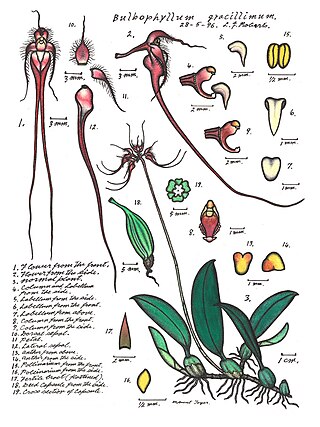
Bulbophyllum gracillimum, commonly known as the wispy umbrella orchid, is a species of epiphytic orchid. It has a creeping rhizome, widely spaced, olive green pseudobulbs, each with a single thick, leathery, fleshy leaf and between six and ten purplish red flowers spreading in a semicircular umbel. The flowers have distinctive long, thread-like tails on the lateral sepals. It has a wide distribution and is found in New Guinea, New Caledonia, Indonesia, Malaysia and part of tropical North Queensland.
Bulbophyllum macphersonii, commonly known as eyelash orchids, is a species of epiphytic or lithophytic orchid that is endemic to Queensland. It has tiny, crowded, slightly flattened, dark green pseudobulbs, a single thick, fleshy leaf and a single dark red to purplish red flower with a narrow labellum. It grows on trees and rocks in sheltered places.

Acianthus fornicatus, commonly known as bristly mosquito orchid or pixie caps, is a species of flowering plant in the orchid family Orchidaceae and is endemic to eastern Australia. It is a terrestrial herb with a single, heart-shaped leaf and up to ten translucent pinkish-red flowers, and is widespread and common in coastal and near-coastal areas.

Caleana, commonly known as duck orchids, is a genus of flowering plants in the orchid family, Orchidaceae that is found in Australia and New Zealand. The Australian species are found in all states but have not been recorded in the Northern Territory. Duck orchids have a single leaf and one or a few, dull-coloured, inconspicuous flowers. Most species are found in Western Australia but one species occurs in eastern Australia and one occurs in eastern Australia and New Zealand. Orchids in this genus as well as the hammer orchids (Drakaea) are pollinated by male thynnid wasps.
Phreatia listeri, commonly known as the Christmas Island caterpillar orchid, is a plant in the orchid family and is an epiphyte with four to six flat, blunt leaves in a fan-like arrangement. A large number of tiny, greenish white flowers are arranged along a thin flowering stem. It is endemic to Christmas Island.
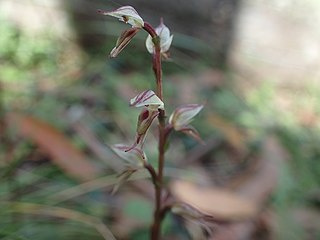
Acianthus apprimus, commonly known as early mosquito orchid, is a species of flowering plant in the orchid family Orchidaceae and is endemic to New South Wales in Australia. It is a terrestrial herb with a single, heart-shaped leaf and between two and nine translucent pinkish flowers with reddish markings and is found in disjunct populations around the state.

Acianthus collinus, commonly known as hooded mosquito orchid or inland mosquito orchid, is a species of flowering plant in the orchid family Orchidaceae and is endemic to south-eastern continental Australia. It is a terrestrial herb with a single, heart-shaped leaf and between two and nine translucent pinkish flowers with reddish markings and is found growing in colonies on sheltered slopes in open forest in on the western slopes of the Great Dividing Range.
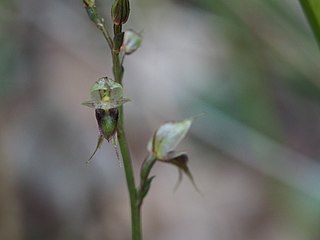
Acianthus exiguus, commonly known as tiny mosquito orchid, is a flowering plant in the orchid family Orchidaceae and is endemic to New South Wales in Australia. It is a terrestrial herb with a single, heart-shaped leaf and up to five translucent greenish-white flowers with pinkish markings and is found growing in forests on the north coast of the state.
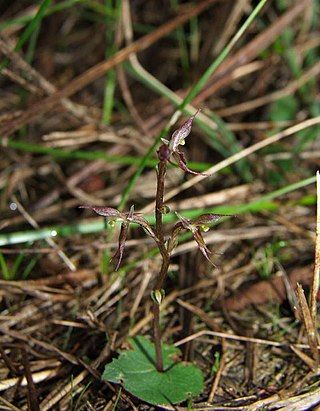
Acianthus pusillus, commonly known as small mosquito orchid, is a species of flowering plant in the orchid family Orchidaceae and is endemic to eastern Australia. It is a terrestrial herb with a single, heart-shaped leaf and up to 18 small, translucent green or pinkish flowers with reddish marking and a green to reddish-purple labellum. It is widely distributed, growing in moist places from central-eastern Queensland, south through New South Wales and Victoria to South Australia and Tasmania.

Pterostylis biseta, commonly known as the bristled rustyhood, is a plant in the orchid family Orchidaceae and is endemic to south-eastern Australia. It has a rosette of leaves at its base and up to seven relatively large, translucent flowers with green and brown marking with a brown to green insect-like labellum with bristly hairs. It occurs in New South Wales, South Australia and Victoria although in the latter state it has been separated into three species and is also under review in New South Wales.

Pterostylis lingua, commonly known as the large-lipped rustyhood, is a plant in the orchid family Orchidaceae and is endemic to south-eastern Australia. It has a rosette of leaves and up to ten dark reddish-brown flowers with translucent "windows" and a blackish, insect-like labellum.

Pterostylis boormanii, commonly known as the Sikh's whiskers, baggy britches, or Boorroans green-hood is a plant in the orchid family Orchidaceae and is endemic to south-eastern Australia. It has a rosette of leaves and up to seven dark reddish-brown flowers with translucent "windows" and a thick, brown, bristly, insect-like labellum.

Pterostylis pusilla, commonly known as the tiny rustyhood is a plant in the orchid family Orchidaceae and is endemic to southern Australia. It has a rosette of leaves and up to nine relatively small green and reddish-brown flowers with translucent white "windows" and a dark brown, insect-like labellum.

Pterostylis tasmanica, commonly known as the small bearded greenhood, is a species of orchid in the family Orchidaceae which is native to south-eastern Australia and New Zealand. It has a single green flower with translucent "windows" and a long, thin labellum bordered with golden hairs. It is similar to P. plumosa but is shorter, with smaller leaves and flowers but a more densely feathery labellum.

Acianthus caudatus, commonly known as mayfly orchid, is a species of flowering plant in the orchid family Orchidaceae and is endemic to eastern Australia. It is a terrestrial herb with a single egg-shaped or heart-shaped leaf and up to nine dark purplish flowers with thin, spreading sepals and petals, often with a musty odour.

Acianthus cuneatus, commonly known as New England mosquito orchid, is a species of flowering plant in the orchid family Orchidaceae and is endemic to the Northern Tablelands of New South Wales. It is a terrestrial herb with a single, heart-shaped leaf and up to seven translucent greenish flowers with purplish stripes and is found growing in sheltered slopes in open forest.
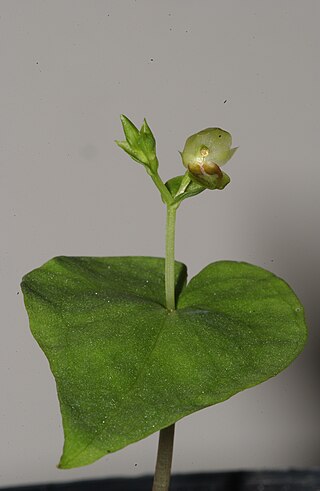
Acianthus saxatilis is a species of flowering plant in the orchid family Orchidaceae and is endemic to Queensland. It is a terrestrial herb with a single, relatively large, heart-shaped leaf and usually up to 5 translucent greenish-brown to greenish-yellow flowers.


















